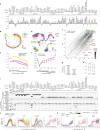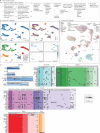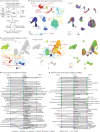A molecular cell atlas of mouse lemur, an emerging model primate
- PMID: 40739356
- PMCID: PMC12328211
- DOI: 10.1038/s41586-025-09113-9
A molecular cell atlas of mouse lemur, an emerging model primate
Abstract
Mouse lemurs are the smallest and fastest reproducing primates, as well as one of the most abundant, and they are emerging as a model organism for primate biology, behaviour, health and conservation. Although much has been learnt about their ecology and phylogeny in Madagascar and their physiology, little is known about their cellular and molecular biology. Here we used droplet-based and plate-based single-cell RNA sequencing to create Tabula Microcebus, a transcriptomic atlas of 226,000 cells from 27 mouse lemur organs opportunistically obtained from four donors clinically and histologically characterized. Using computational cell clustering, integration and expert cell annotation, we define and biologically organize more than 750 lemur molecular cell types and their full gene expression profiles. This includes cognates of most classical human cell types, including stem and progenitor cells, and differentiating cells along the developmental trajectories of spermatogenesis, haematopoiesis and other adult tissues. We also describe dozens of previously unidentified or sparsely characterized cell types. We globally compare expression profiles to define the molecular relationships of cell types across the body, and explore primate cell and gene expression evolution by comparing lemur transcriptomes to those of human, mouse and macaque. This reveals cell-type-specific patterns of primate specialization and many cell types and genes for which the mouse lemur provides a better human model than mouse1. The atlas provides a cellular and molecular foundation for studying this model primate and establishes a general approach for characterizing other emerging model organisms.
© 2025. The Author(s).
Conflict of interest statement
Competing interests: The authors declare no competing interests.
Figures















References
-
- Mestas, J. & Hughes, C. C. Of mice and not men: differences between mouse and human immunology. J. Immunol.172, 2731–2738 (2004). - PubMed
-
- Watase, K. & Zoghbi, H. Y. Modelling brain diseases in mice: the challenges of design and analysis. Nat. Rev. Genet.4, 296–307 (2003). - PubMed
-
- IUCN. IUCN Red List of Threatened Species. IUCNhttps://www.iucnredlist.org/en (2022).
MeSH terms
Grants and funding
- R35 GM136433/GM/NIGMS NIH HHS/United States
- P30 EY026877/EY/NEI NIH HHS/United States
- R25 CA180993/CA/NCI NIH HHS/United States
- P01 AG036695/AG/NIA NIH HHS/United States
- R35 GM139517/GM/NIGMS NIH HHS/United States
- K99 AG066963/AG/NIA NIH HHS/United States
- R01 AR073248/AR/NIAMS NIH HHS/United States
- R01 NS050835/NS/NINDS NIH HHS/United States
- P30 DK116074/DK/NIDDK NIH HHS/United States
- R01 AG068667/AG/NIA NIH HHS/United States
- R01 DC016892/DC/NIDCD NIH HHS/United States
- T32 AI007290/AI/NIAID NIH HHS/United States
- R01 GM061986/GM/NIGMS NIH HHS/United States
- DP2 AI138242/AI/NIAID NIH HHS/United States
- R01 AI024258/AI/NIAID NIH HHS/United States
- R01 GM116847/GM/NIGMS NIH HHS/United States
- T15 LM007033/LM/NLM NIH HHS/United States
- RF1 AG077443/AG/NIA NIH HHS/United States
LinkOut - more resources
Full Text Sources

